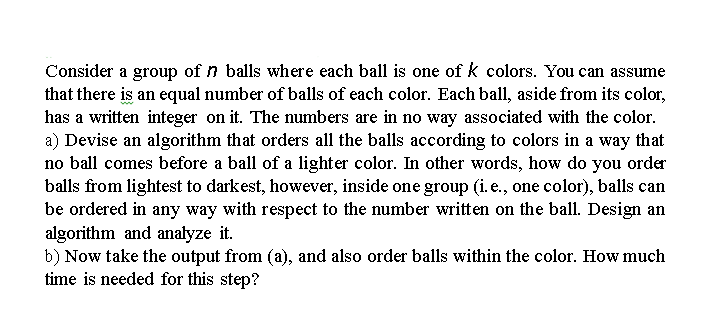Consider a group of ♬ balls where each ball is one of k colors. You can assume that there is an equal number of balls of each color. Each ball, aside from its color, has a written integer on it. The numbers are in no way associated with the color. a) Devise an algorithm that orders all the balls according to colors in a way that no ball comes before a ball of a lighter color. In other words, how do you order balls from lightest to darkest, however, inside one group (i. e., one color), balls can be ordered in any way with respect to the number written on the ball. Design an algorithm and analyze it. b) Now take the output from (a), and also order balls within the color. How much time is needed for this step?
Consider a group of ♬ balls where each ball is one of k colors. You can assume that there is an equal number of balls of each color. Each ball, aside from its color, has a written integer on it. The numbers are in no way associated with the color. a) Devise an algorithm that orders all the balls according to colors in a way that no ball comes before a ball of a lighter color. In other words, how do you order balls from lightest to darkest, however, inside one group (i. e., one color), balls can be ordered in any way with respect to the number written on the ball. Design an algorithm and analyze it. b) Now take the output from (a), and also order balls within the color. How much time is needed for this step?
Database System Concepts
7th Edition
ISBN:9780078022159
Author:Abraham Silberschatz Professor, Henry F. Korth, S. Sudarshan
Publisher:Abraham Silberschatz Professor, Henry F. Korth, S. Sudarshan
Chapter1: Introduction
Section: Chapter Questions
Problem 1PE
Related questions
Question

Transcribed Image Text:Consider a group of balls where each ball is one of k colors. You can assume
that there is an equal number of balls of each color. Each ball, aside from its color,
has a written integer on it. The numbers are in no way associated with the color.
a) Devise an algorithm that orders all the balls according to colors in a way that
no ball comes before a ball of a lighter color. In other words, how do you order
balls from lightest to darkest, however, inside one group (i. e., one color), balls can
be ordered in any way with respect to the number written on the ball. Design an
algorithm and analyze it.
b) Now take the output from (a), and also order balls within the color. How much
time is needed for this step?
Expert Solution
This question has been solved!
Explore an expertly crafted, step-by-step solution for a thorough understanding of key concepts.
Step by step
Solved in 3 steps

Knowledge Booster
Learn more about
Need a deep-dive on the concept behind this application? Look no further. Learn more about this topic, computer-science and related others by exploring similar questions and additional content below.Recommended textbooks for you

Database System Concepts
Computer Science
ISBN:
9780078022159
Author:
Abraham Silberschatz Professor, Henry F. Korth, S. Sudarshan
Publisher:
McGraw-Hill Education

Starting Out with Python (4th Edition)
Computer Science
ISBN:
9780134444321
Author:
Tony Gaddis
Publisher:
PEARSON

Digital Fundamentals (11th Edition)
Computer Science
ISBN:
9780132737968
Author:
Thomas L. Floyd
Publisher:
PEARSON

Database System Concepts
Computer Science
ISBN:
9780078022159
Author:
Abraham Silberschatz Professor, Henry F. Korth, S. Sudarshan
Publisher:
McGraw-Hill Education

Starting Out with Python (4th Edition)
Computer Science
ISBN:
9780134444321
Author:
Tony Gaddis
Publisher:
PEARSON

Digital Fundamentals (11th Edition)
Computer Science
ISBN:
9780132737968
Author:
Thomas L. Floyd
Publisher:
PEARSON

C How to Program (8th Edition)
Computer Science
ISBN:
9780133976892
Author:
Paul J. Deitel, Harvey Deitel
Publisher:
PEARSON

Database Systems: Design, Implementation, & Manag…
Computer Science
ISBN:
9781337627900
Author:
Carlos Coronel, Steven Morris
Publisher:
Cengage Learning

Programmable Logic Controllers
Computer Science
ISBN:
9780073373843
Author:
Frank D. Petruzella
Publisher:
McGraw-Hill Education